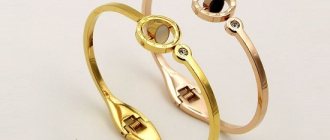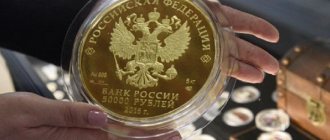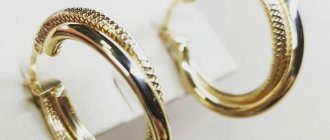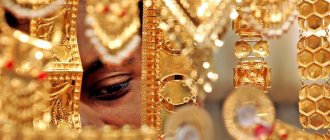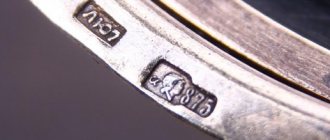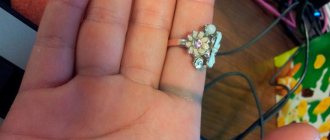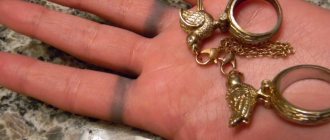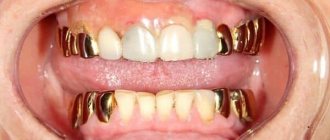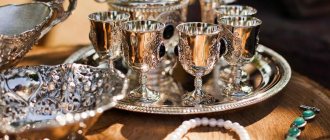Red gold - origin story
Chervonny (scarlet), translated from Old Church Slavonic, means red, scarlet; in Tsarist Russia, chervonets were originally the name given to foreign gold coins: ducats, sequins, and florins. Russia's own coins have been minted since the 15th century as insignia.
The first Russian gold products as a means of payment appeared as a result of the monetary reform of Peter I. They corresponded in weight and alloy value to foreign coins and were intended only for settlements with foreign subjects.
It was customary to make expensive jewelry from chervonets, since purer gold simply did not exist in those days due to the lack of possibilities for higher purification. Therefore, red gold is still mistakenly considered the name of a chemically pure element.
Where is the metric analogue sold - 585 standard
Jewelry made in the Russian Federation is tested. On the product you can see the mark 585. This is an analogue of the gold of Tsarist Russia only in terms of the content of the main precious metal. Otherwise, jewelry represents a separate category. Accordingly, you can purchase them in jewelry stores.
Sample 585 gold
Mining pure gold
Some of the yellow metal is mined in the form of nuggets or sand, that is, in its original metallic state. The purity of the precious metal largely depends on the properties of the deposit in which it is mined. The composition of the gold in a nugget can vary over a very wide range, and its further improvement to the desired grade can only be achieved through subsequent purification.
Industrial metal mining is carried out using large millstones through which the rock is washed. Among the chemical methods for obtaining gold, there are three:
- merger;
- cyanidation;
- recycling.
Amalgamation is one of the oldest methods of separating gold, crushed rock is mixed with mercury, which then surrounds the precious metal, after which all that is left is to separate the mercury from the rock, and then the gold from the mercury. The expensive method is used in plants that process rocks with high gold content.
Cyanidation is most often used to produce niobium gold. This method is carried out at large mining enterprises; gold is dissolved in hydrocyanic acid salts and then extracted from the resulting solution.
Price
For 2022, the price of gold at 583 and 585 is practically the same. It ranges from 2900 to 6000 rubles. As for the pawnshop, the price per gram will not exceed the threshold of 1,700 rubles.
In Ukraine, the situation is similar: both samples are sold and bought at almost the same price. Here you can get about 1000 UAH per gram, but the amount more or less directly depends on a number of indicators, for example, on the manufacturer. In a Ukrainian pawnshop they will give no more than 600 UAH per gram of Soviet gold.
Red gold - how many impurities are in the alloy?
It is well known that pure gold has a yellow color, but depending on the presence of impurities in the composition, it changes color. The following are used as ligatures:
- copper;
- silver;
- palladium;
- zinc;
- aluminum;
- nickel
- cadmium;
- platinum.
When heated, copper gives this precious yellow metal an aristocratic reddish tint. The more copper in the alloy, the brighter the shade. However, such alloys have a very significant drawback - unlike pure gold, this alloy is already susceptible to corrosion.
Unlike copper, aluminum does not reduce corrosion resistance, but strengthens the alloy. Silver gives the yellow metal a greenish or whitish tint; impurities of platinum and palladium also change the color of gold from yellow to white.
What is it made from, what impurities are added?
Red gold is created by adding no more than 10% copper to pure raw materials. The net weight of each component is called the alloy weight.
Modern products are somewhat different due to the addition of a certain amount of silver, and accordingly, the standard is much lower.
The three-component metal has become widespread due to its high characteristics of malleability, ductility, and strength. The created products turn out to be very wear-resistant, despite the fact that it is almost impossible to visually distinguish them without special knowledge.
Depending on the shade of the product, you can determine which additive was added.
The red material is formed by adding 33.5% copper, 8% silver. When silver is added another 1%, and copper is reduced by 1.5%, a pink color is obtained.
Using 30% silver with 11.5% copper produces a lemon color. When 3% copper, 10% silver, 3.5% zinc and 25% nickel are added to gold, the color produced is white.
The olive tint is formed as a result of the addition of 4% cadmium, 15% silver, 6% copper.
Modern technologies have expanded the overall palette by three more shades. Blue color is obtained by mixing with 54% indium, amethyst - from the introduction of 21% aluminum, and black - 25% cobalt.
Properties of pure gold
Pure gold is a very soft metal; On a 10-point hardness scale (Mohs scale), which assigns a 10 to a diamond, gold only scores 3.
If a 999 wedding ring accidentally falls off your finger and hits a hard floor, it will become very deformed, almost flattened, and it will be impossible to put it back on your finger.
Therefore, pure gold is almost never used to make jewelry. On the other hand, pure gold is a very dense metal, second only to the platinum group metals.
Its properties are widely used in electronics; it is used to coat the contact surface to protect against corrosion. The melting point of pure gold is 1063 °C, but with the help of alloys it can be lowered or increased. A decrease in the melting point is provided by silver, zinc, and cadmium; an increase is provided by impurities of platinum and palladium. Did you know that cadmium, which gives gold its green color, is prohibited for use in the EU countries and the Russian Federation. Metal makes gold jewelry dangerous, details here...
Composition and properties of metal
The general composition includes different proportions, but high-grade products always contain at least 90% pure gold.
Red metal is almost no different from pure raw materials in terms of functional parameters - it is malleable, soft, fusible, and has a tendency to abrasion and deformation even when tested the “old-fashioned way” - by squeezing between teeth. An impression of the teeth remains on the surface of the chervonets.
Today, red metal is used mainly in the creation of jewelry. You can also find products made from it inside various museums, where ancient coins and family jewelry are displayed.
The material enjoyed particular success in the manufacture of wedding rings.
Pros and cons of red gold
Only high-quality alloys have advantages in the form of sufficient strength; in other cases, excessive fragility and softness are observed. The surface of products made of this metal is characterized by low resistance to damage - the slightest scratch will be quickly noticeable.
Products made from forged gold often break and their repair is expensive. At the same time, pay attention to the absolute resistance of the metal to corrosion.
It is not recommended to scratch the metal, as there is a high probability of damage to the top layer.
Jewelry made from red gold of the last century has historical value, gold chervonets have numismatic value, they can be sold at a high price or bought profitably as a long-term investment - the older the object, the higher its value.
How to properly care for gold jewelry
Gold products are highly resistant to external factors, but need to be cleaned from household dirt. This is especially true for items for everyday wear.
There are several ways to carry out this procedure at home:
- Place items in the saline solution for 12 hours, then rinse thoroughly. To prepare the solution you will need a glass of boiled water and 3 tablespoons of salt.
- You can also use a mixture of ammonia and soap; 2 hours will be enough to clean jewelry, then the solution is washed off with plenty of water. Ingredients: a teaspoon of ammonia and liquid soap per glass of boiled water.
- Without pressing, wipe the products with a cotton swab dipped in three percent hydrogen peroxide, leave for 15 minutes, then rinse with plenty of water.
Plastic or ceramic containers are used for soaking jewelry, but not metal ones. After rinsing, they are carefully and thoroughly wiped with lint-free wipes and polished with suede.
Due to its softness, the cleaning of items and jewelry made of red gold should be entrusted to a jeweler.
Where is pure gold used?
Precious metal has always been of great importance in the history of mankind, affecting the cultural, financial and production spheres of society. Since ancient times, the precious metal has been used as a standard of value in the financial sector. Bullion and bullion coins are made from gold, the metal is actively traded on the stock market, and many countries choose to store their funds in gold.
Pure gold is widely used in industry and plays a special role in electronics and electrical engineering. The precious metal is used to gold-plate contacts to prevent oxidation and improve durability, and are found in every mobile phone, tablet or laptop. Gold is in every car: in addition to electronics, it is present in catalytic converters.
High-grade gold is widely used in jewelry, and the combination of metal and precious stones allows craftsmen to create incredibly beautiful jewelry. Adding components to the alloy alloy makes it possible to obtain unusual shades of metal, which helps to expand the jewelry collections of world manufacturers.
Recommendations for caring for antique gold
Vintage items must be cared for with care, be it a ring, earring, chain or other jewelry. Basic recommendations:
- to maintain shine, regularly clean the products with a lint-free cloth soaked in a soap solution, but this should be done not once a year, but if necessary, preferably more often, in order to avoid the formation of a greasy coating as it wears;
- You cannot use abrasive agents, and the ban applies not only to stones, but also to precious metals;
- It is recommended to purchase a special paste - you can find it in jewelry stores.
Red gold and its purity
In Soviet times, red gold was considered the standard of quality and corresponded to 585 fineness of the metal. It is with this standard that the term “red metal” is often confused; red gold has an average content of precious metal of 585 fineness, and red metal has the highest standard.
Foreign jewelers do not like red gold, the reason is not only in the middle range, many craftsmen believe that a precious metal with such shades is not suitable as a setting for precious stones. In recent years, the red color of the metal is more often used for jewelry of unusual designs, excluding the insertion of stones.
Due to its low price, red gold has been on the market in our country since Soviet times. The advantages of this metal include another physical quality of jewelry: jewelry made from the red alloy is durable enough to withstand daily wear.
Stamp on products before and after 1897
The end of the 19th century was also marked by a transition from the old branding method to a new one. Until 1897, convex tests were applied to products made of jewelry alloys. Moreover, their size depended on the dimensions of the product. This means that the brand could sometimes create discomfort when worn. Soon the branding method was changed. The sample was not noticeable. It was flush with the metal. Today, a stamp is also used.
Types of stamps on gold items
The stamp of those times depicted a woman’s head in a kokoshnik. But already in 1927, another option began to be used. It depicted the head of a worker with a hammer. All types of marks are found on antique products. However, if the external signs of 56-carat gold are studied, you will notice that the designation on it was different even then. There is a stamp with letters. This may indicate the jeweler's initials. There is another option - applying the initials of the manager of the assay district.
How to decipher a gold sample
If we talk about the metric system, then the mark on the precious metal shows how many grams of pure substance are contained in a kilogram of the alloy. For example, hallmark 585 means that 1 kg of alloy contains 585 grams, or 58.5% gold.
In the carat grading system, a chemically pure substance has a grade of 24 carats. The 22 carat mark is equivalent to the 916 metric mark and the 14 carat mark is equivalent to the 585 metric mark.
The unit of measurement in the spool system is the pound, equal to 96 gold units.
| Gold content | Carats | Spool measure |
| 375 | 9 | 36 |
| 500 | 12 | 48 |
| 585 | 14 | 56 |
| 750 | 18 | 72 |
| 875 | 21 | 84 |
| 916 | 22 | 88 |
| 947 | 22 | 91 |
| 958 | 23 | 92 |
| 999 | 24 | 96 |
Question-answer section
56 gold standard corresponds to what standard?
Expert opinion
Pribrezhny Gennady Valentinovich
Jeweler 6th category
Jewelry alloy can be converted into any of the existing systems for assessing metal purity. If we take the metric as a basis, then 56-carat gold will correspond to only 1 option - 585. In the karat system there is also an analogue with the same properties and degree of purity - 14K.
Gold purity 56 on the ring and the letters - what does this mean?
Expert opinion
Grishanov Mikhail Petrovich
Jeweler, director of the Grishanov and Co. workshop
It matters what numbers the sample contains. The numerical option is now popular. It consists of only numbers. But sometimes among old things you find an item with a mark that also contains letters. This may mean the initials of the jeweler, the manager of the assay district. Today, too, on products made of precious alloy you can find 2 marks, instead of one. Among them there is a name sign, signifying belonging to a jewelry house or manufacturer.
Gold wedding ring
Red gold is not 999 fine
Gold mined in mines is not a perfectly pure metal and already contains a number of impurities. However, after purification, the metal turns into precious 999 fine bars and is sent to banks for storage. A pure gold bar can be damaged, scratched and bent without much effort. At the same time, many mistakenly call 999 fineness the devil's gold, meaning by this term a perfectly refined precious metal.
Red gold is an alloy of gold and copper, due to the ligature, a reddish noble shade of the precious metal is obtained.
The cost of high-grade gold
The noble metal served as the basis for the emergence of commodity-money relations and to this day is a stable international currency. Its value is formed as a result of exchange trading and has been steadily growing in price in recent years.
Price per 1 gram
You can find out how much a high-grade pure gold alloy costs right now, online, on our website using the chart.
Similar information on changes in the cost of bank gold per gram is presented in tabular format for the convenience of users.
| Price 999 standard according to the Central Bank | Market value of the sample today | Scrap price | Price in jewelry |
Red gold coins
And now a few more words about the minting of red gold coins. The historical period in which certain “chervonets” were made is important. For example, during the reign of Tsar Nicholas II, the mint minted gold coins of only 900 fineness, which corresponds to 86.4 spools.
In more ancient times, when Russia was ruled by Peter I, mints produced coins from pure 94-carat gold, which was only slightly inferior to the modern 999-carat gold. However, it is known that, along with 94-carat gold, lower carats were also used to produce coins. As such, these coins had less value and were intended for use within the state.
Color
From the Old Slavic language the adjective chervonny is translated as red. This explains the origin of the term “red gold”. On the other hand, the adjective chervonny (chervilny) comes from the words “worm” and “worm”, which means a red tint or simply to paint. In turn, the root of these words comes from the name of a certain kind of worm, from which red dye was prepared in ancient times. After many centuries had passed, the term “chervonets” began to be applied to the royal coins of the Russian Empire, and then to the chervonets of the USSR.
Jewelry made of red gold
Various pieces of jewelry were made from this same gold, but due to its fragility and delicacy, all antique jewelry was not intended for everyday use, as it is today. They were a kind of showcase of wealth and social status; they served only as family jewelry, passed on from generation to generation. The only exception can be considered individual massive gold objects in the form of rings, bracelets and chains, the fragility of which was compensated by the significant thickness of the metal.
However, nowadays the term "red gold" is often used to refer to the 999.9 purity metal, which, contrary to its name, has a bright yellow hue.
How it is made
Red gold is obtained by introducing a certain amount of copper into the composition. Such additions to precious metals are called alloys.
Nowadays, an alloy of a similar shade is also used, but its standard is much lower, and in addition to copper, it contains silver. This three-component alloy is widely used today due to its good strength and malleability. It lends itself well to soldering. Products made from this alloy are more durable, and the visual difference between the two types of gold is a slight difference in shades of red and is noticeable only upon close inspection.
Next, watch an interesting video about how gold is made:
How to distinguish real gold from fake?
The authenticity of numismatic items is verified exclusively by jewelry stores and the Assay Office. They use modern equipment that guarantees highly accurate analysis, preventing damage to valuable items.
You can inspect the item yourself for signs of fraud, such as small chips, minor dents or partial wear. Many scammers skim some of the gold from each item, selling it at full price.
How to choose red gold coins
Coins must necessarily indicate: fineness, number of the mint that issued the banknote, designation of the metal according to the periodic table, ligature weight of gold.
The front side always depicts the state emblem, the emblem of the issuing bank or artistic symbols. On the reverse side are embossed images of memorable events or portraits.
When buying jewelry, always pay attention to the weight: jewelry is never light, especially openwork jewelry made of red gold. Such a soft material cannot maintain its shape on its own, so it is necessary to add strengthening impurities to the overall alloy. As a result, the weight of the final product may increase significantly.
Experts warn: openwork jewelry with a purity higher than 750 is always a fake. It is important to remember here that the more gold, the higher the standard and the lower the hardness characteristics of the product.
Sample history
Since the times of the Soviet Union, people have become accustomed to believing that 583 gold is the best. But this is not entirely true: those who understand alloys immediately understood this. But for many ordinary people this was a big discovery. Evidence that gold is not of the highest quality is its deteriorating appearance, namely darkening many years after its purchase.
But Soviet jewelry has another useful feature - it is very durable and difficult to deform. This was done so that the thin rings, which were one of the best-selling rings at that time, would not bend and confuse buyers. If you compare the price per ounce of gold then and now, it has increased by $1,400. Given the rise in price, people are trying to buy products of the highest standard.
What it is
Most people are of great interest in red gold, the purity of which is almost the highest. Translated from English (pure gold) this is pure gold, which is not entirely true, because a ligature is mixed into its composition. Copper is most often used as an impurity, which gives it a red tint. Quite often, the phrase pure gold is used to denote pure precious metal without additions, and yellow gold is also called red gold.
In its pure form, aurum is too malleable, so alloys are used to make jewelry. To add strength, enhance shine and obtain a varied tint palette, jewelers add various impurities. It is impossible to unequivocally answer the question “what type of alloy can be called red?” Gold, the marking of which exceeds the modern 900th, can be considered red.
Reason for popularity
Gold of 583 and 585 samples still remains popular in Russia. It is almost impossible to distinguish them; only a professional can do this, but more on that a little later. What made this gold so popular and sold even in our time?
In the Soviet era, products were largely valued because of their reliability and resistance to wear and other external irritants. The jewelers understood this very well and worked to achieve the desired result. Those who did not neglect the care of the condition of the products, until our time, were able to preserve them in the form in which they were at the time of purchase.
Interesting! The most purchased standard in Europe today is the 750 mark. She is also popular among accomplished people in Russia.
